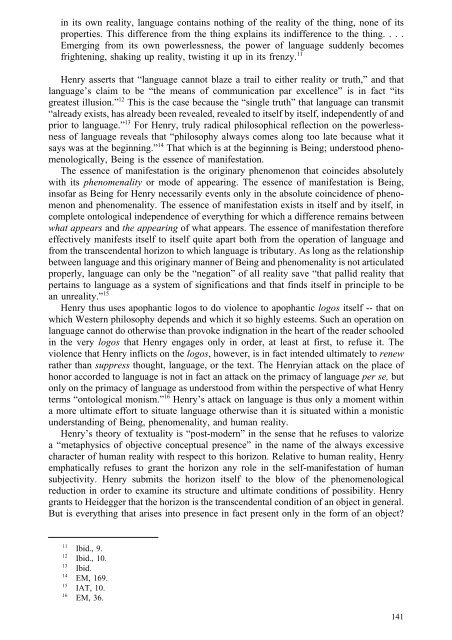[Andrzej_Wiercinski_(ed ... - WordPress.com
[Andrzej_Wiercinski_(ed ... - WordPress.com
[Andrzej_Wiercinski_(ed ... - WordPress.com
You also want an ePaper? Increase the reach of your titles
YUMPU automatically turns print PDFs into web optimized ePapers that Google loves.
in its own reality, language contains nothing of the reality of the thing, none of itsproperties. This difference from the thing explains its indifference to the thing. . . .Emerging from its own powerlessness, the power of language suddenly be<strong>com</strong>esfrightening, shaking up reality, twisting it up in its frenzy. 11Henry asserts that “language cannot blaze a trail to either reality or truth,” and thatlanguage’s claim to be “the means of <strong>com</strong>munication par excellence” is in fact “itsgreatest illusion.” 12 This is the case because the “single truth” that language can transmit“already exists, has already been reveal<strong>ed</strong>, reveal<strong>ed</strong> to itself by itself, independently of andprior to language.” 13 For Henry, truly radical philosophical reflection on the powerlessnessof language reveals that “philosophy always <strong>com</strong>es along too late because what itsays was at the beginning.” 14 That which is at the beginning is Being; understood phenomenologically,Being is the essence of manifestation.The essence of manifestation is the originary phenomenon that coincides absolutelywith its phenomenality or mode of appearing. The essence of manifestation is Being,insofar as Being for Henry necessarily events only in the absolute coincidence of phenomenonand phenomenality. The essence of manifestation exists in itself and by itself, in<strong>com</strong>plete ontological independence of everything for which a difference remains betweenwhat appears and the appearing of what appears. The essence of manifestation thereforeeffectively manifests itself to itself quite apart both from the operation of language andfrom the transcendental horizon to which language is tributary. As long as the relationshipbetween language and this originary manner of Being and phenomenality is not articulat<strong>ed</strong>properly, language can only be the “negation” of all reality save “that pallid reality thatpertains to language as a system of significations and that finds itself in principle to bean unreality.” 15Henry thus uses apophantic logos to do violence to apophantic logos itself -- that onwhich Western philosophy depends and which it so highly esteems. Such an operation onlanguage cannot do otherwise than provoke indignation in the heart of the reader school<strong>ed</strong>in the very logos that Henry engages only in order, at least at first, to refuse it. Theviolence that Henry inflicts on the logos, however, is in fact intend<strong>ed</strong> ultimately to renewrather than suppress thought, language, or the text. The Henryian attack on the place ofhonor accord<strong>ed</strong> to language is not in fact an attack on the primacy of language per se, butonly on the primacy of language as understood from within the perspective of what Henryterms “ontological monism.” 16 Henry’s attack on language is thus only a moment withina more ultimate effort to situate language otherwise than it is situat<strong>ed</strong> within a monisticunderstanding of Being, phenomenality, and human reality.Henry’s theory of textuality is “post-modern” in the sense that he refuses to valorizea “metaphysics of objective conceptual presence” in the name of the always excessivecharacter of human reality with respect to this horizon. Relative to human reality, Henryemphatically refuses to grant the horizon any role in the self-manifestation of humansubjectivity. Henry submits the horizon itself to the blow of the phenomenologicalr<strong>ed</strong>uction in order to examine its structure and ultimate conditions of possibility. Henrygrants to Heidegger that the horizon is the transcendental condition of an object in general.But is everything that arises into presence in fact present only in the form of an object?111213141516Ibid., 9.Ibid., 10.Ibid.EM, 169.IAT, 10.EM, 36.141


